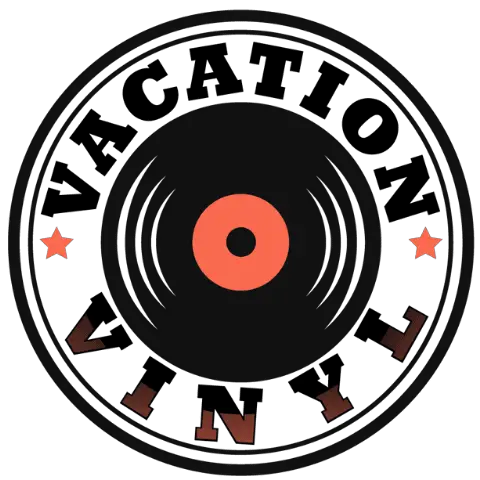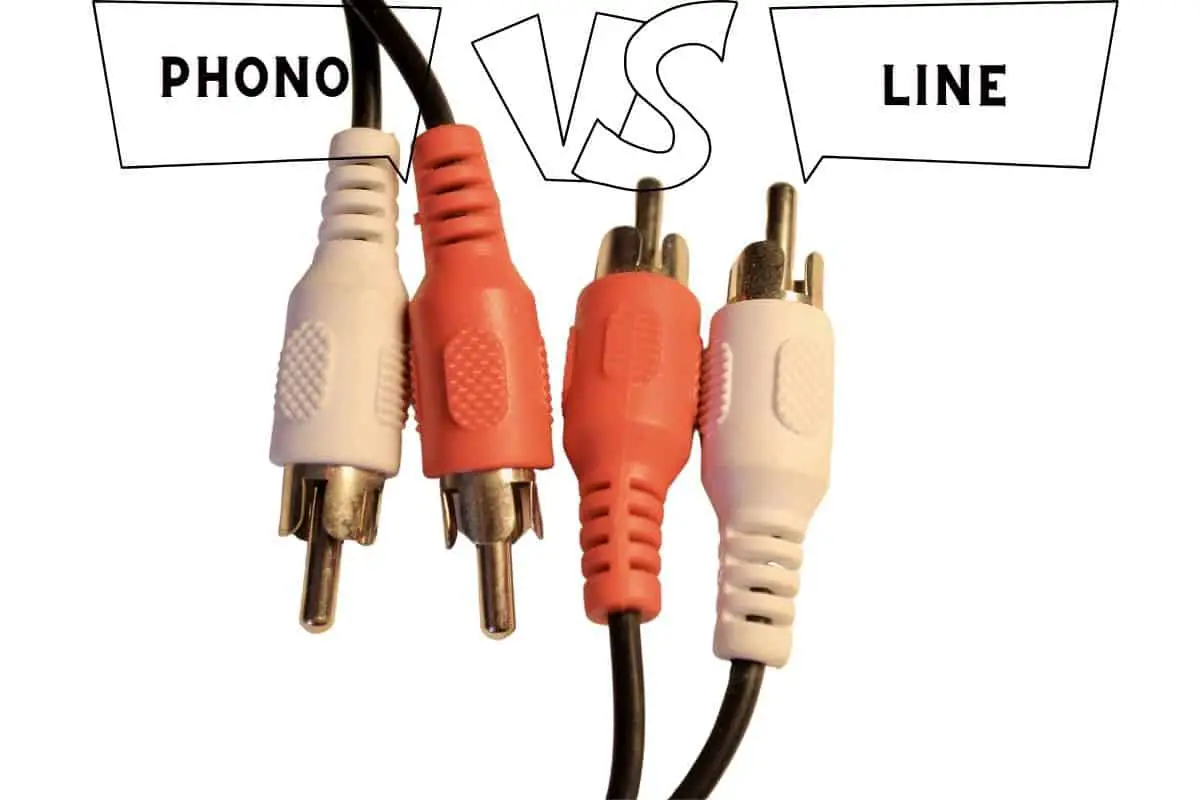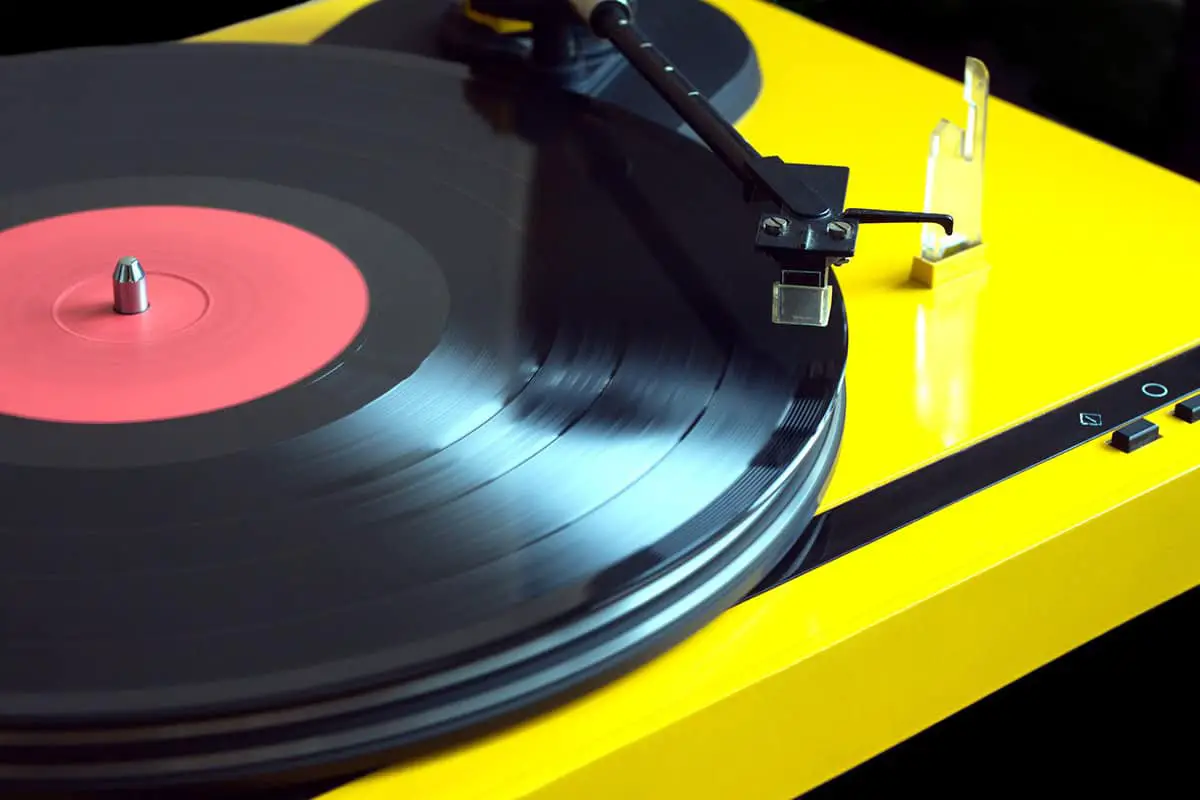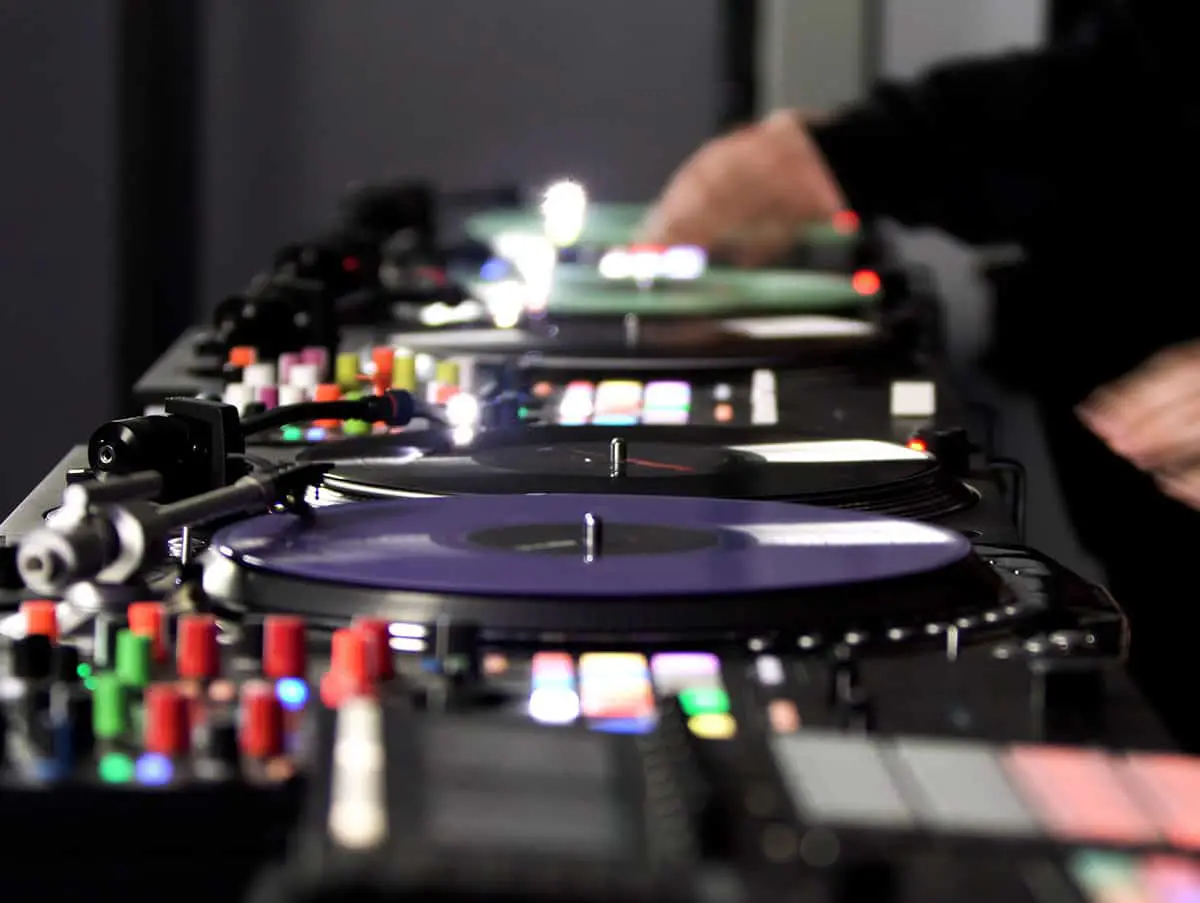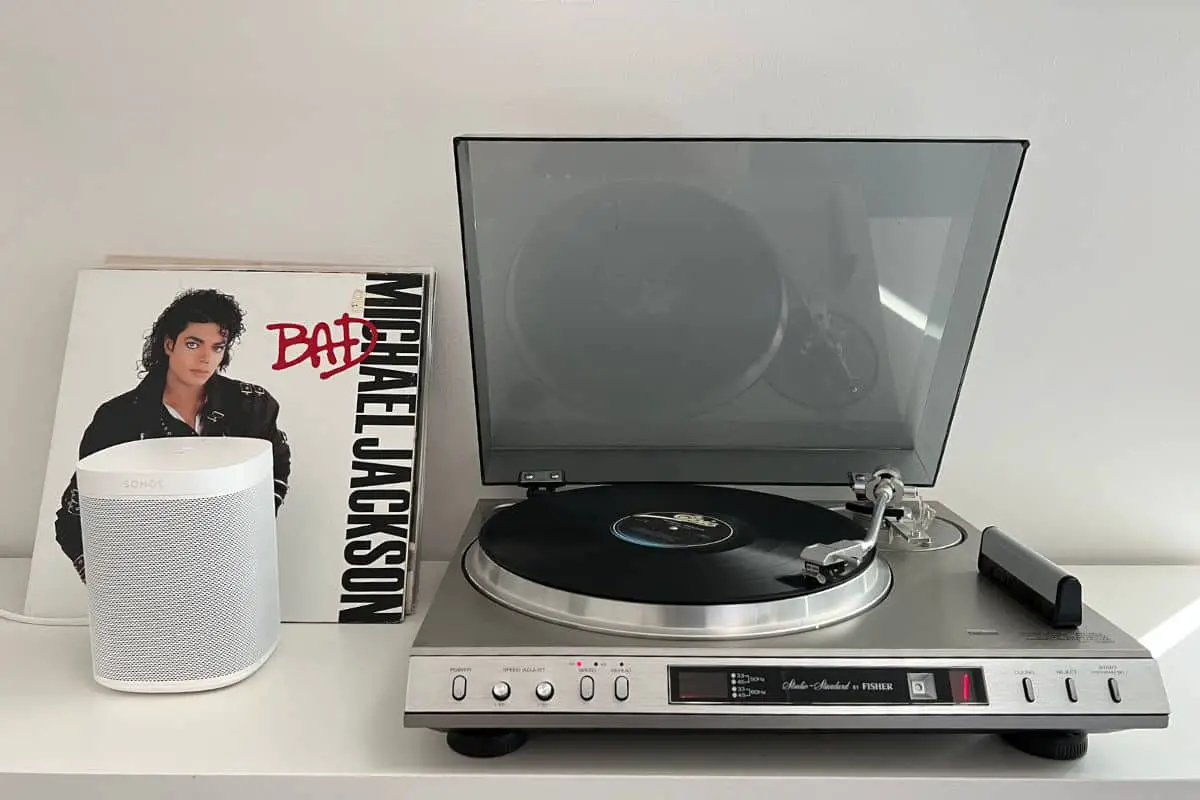This post contains affiliate links.
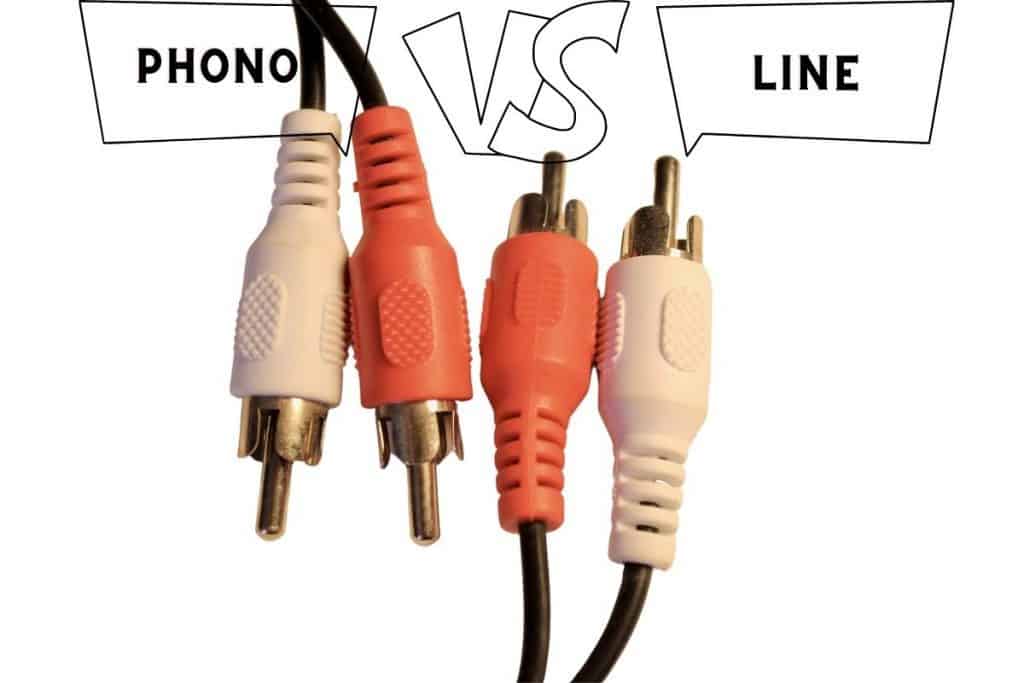
In 1877, the invention of vinyl altered the way the world hears music and audio. Over time, technology has evolved away from the phonograph; however, many continue to enjoy the audio they produce. For this reason, newer audio players include an input labeled phono. But how does the phono input differ from the line input?
Phono produces a very mild electrical signal; meanwhile, line, which encompasses most digital audio players, creates a much stronger signal. This variation impacts the quality of the audio played. To play a phonograph properly, the device must translate its signal through a phono stage, or a preamp.
While listening to vinyl is a relaxing way to pass the time, understanding the signals, inputs, and outputs associated with audio playing devices complicates the hobby. Luckily, we are here to explain it to you! In this article, you will learn everything you need to know about phono and line signals. Let’s get started.
Table of Contents
What is Phono Signal?
When a record is made, the recorded sounds are processed onto the vinyl in grooves. These grooves are essentially a physical representation of the soundwaves. The soundwaves in the grooves are then detected by the needle of a record player.
As the needle passes over it, it reads the electromagnetic signals stored in the vinyl and transforms them into an electrical signal. This electrical signal is then translated by the device’s speakers as sound.
To make more room on a record and to increase the duration of sound on each side, vinyl makers alter the recorded audio’s frequencies.
For example, they must raise the bass’s frequency to make room on the vinyl for multiple songs. Because bass has larger soundwaves, if they were left unaltered, they would take up too much space on the record. The needle would not have enough room to play the song properly, if at all.
When you raise the bass, you also have to boost the treble. Heightening the treble on vinyl during production improves the quality of the audio.
Records with altered frequencies are known as phono signals. Phono signals are considered “unequalized.” Were you to play this through a phonograph, the sound would not play as recorded.
Since the sounds recorded on the vinyl have increased frequencies, they must be corrected before they are played. This is where RIAA Equalization comes into play.
RIAA Equalization process and normalizes the frequencies of the vinyl to produce the sound correctly. This process can also reduce the effects of dust, debris, hand oils, and other substances that alter a vinyl’s sound.
Phono signals only produce about 0.2 to 0.8 millivolts. On a turntable or other modern-day audio device, this is not enough signal to play the sound audibly. Think of it like only half the headphone jack is plugged into your iPod or mp3. The sound playing through the speakers is muffled due to a lack of electricity produced.
Phono Signal and Preamp
Because phono signals are too weak for most audio devices to process, the electrical signal must be increased. This process is done with a phono preamp or a phono stage.
If you were to play a record without the use of a preamp you wouldn’t be able to hear it, and what you could hear would sound odd.
Phono preamps are what enact the RIAA equalization process. The frequencies are lowered and the sound is balanced.
A phono stage may be built into a turntable, record player, CD player, and DVD player. However, some devices will not include the equalization stage needed to play a phonograph properly. Luckily, a preamp can also be found as a stand-alone piece of equipment. Many audio or record repair stores still have these machines on hand.
Some modern audio devices will not need a phono stage since they can identify the difference between vinyl and a CD.
Remember to be careful when handling vinyl. While CDs will not be affected much by fingerprints, fingerprints on vinyl will result in static and background noise. Luckily, most of these imperfections will be buffed out in the equalization process.
What is Line Signal?
The term line signal refers to the natural frequency or basic standard level of audio output that you are used to hearing before any major amplification.
Devices such as CD players, DVD players, laptops, phones, and televisions will output a line signal without any alterations or amplifications.
Line signals are much stronger than phono signals. While a phono signal is only a fraction of a millivolt, a line signal is 0.316 volts root-mean-square.
Because these audio recordings produce a much larger electrical signal, they do not require additional amplification. When you plug a device into the line input, it will play the sound without altering the electrical signals.
Line Input VS Line Output
You may see the word line on the back of your turntable or other audio playing device multiple times. While one of the labels will be close to the word “phono” others might say “line-in” or “line output.”
Are these related to line signals? Not entirely.
The line input port close to the phono input port is meant to plug the audio device into as described above. The others have unique purposes.
The port labeled for line-in is meant to assist with maintaining audio quality while recording.
Meanwhile, the line output jack is where additional external amplification can be plugged in. This could be a PA system, headphones, or recording equipment.
The Differences Between Phono and Line
Phono and line have several differences every vinyl collector should be aware of. Speaker variation will impact your listening experience.
Differences between phono and line have to do with the size of the electrical signals produced and the quality of sound.
The phono input is the older version and newer systems have stopped including it. As described earlier, the needle of a record player travels over the vinyl, it creates an electric signal that is then transformed into sound. The amount of electrical signal produced is the main difference between phono and line systems.
As mentioned earlier, line signal is stronger than phono signal. Phono signals are between about 0.2 to 0.8 millivolts; meanwhile, a line signal is 0.316 volts.
Why does the signal produce matter? The signal created translates to the volume, and quality, of the audio played.
Earlier on, we learned that phono signals travel through a preamp before it gets played through the speakers. If you plug a phono into the line input, the signal will be too weak to hear. On the other hand, if you plug a line into a phono, the already loud signal will be amplified and will be too loud for the speakers to translate properly.
Remember, not all turntables have a built-in preamp. If your turntable struggles to play phonographs, you may need to invest in a preamp.
If your turntable features a phono, line switch, how does it affect the sound played? Turntables with this switch will only have one type of input port. Rather than distinguishing the type of signal being played through the type of port, the switch tells the machine how to read the signal.
When the switch is set to the phono, play the audio at the regular phono signal level. This will result in a quieter output that might include significant background noise.
When you change the settings to the line, the signal produced increases, and background noise is removed. This setting runs the signal through a phono stage equalizing the frequencies and preparing it to be played line quality levels. Phono signals need to be boosted between 50 and 1000 times to be at an acceptable level of line signal.
Phono Line Turntable and Preamp Examples
As record players have had a surge of popularity, many companies have begun to manufacture them again. Many listeners enjoy customizing and upgrading standard phonographs and record players to meet their audio preferences.
To leave room for customization and upgrades, not every record player has a phono preamp built-in. Brands such as Victrola, Yamaha, Technica offer players with and without the preamp. With prices that range from fifty dollars to seven hundred and fifty dollars. While these brands can get a bit more expensive, their machines have a lot to offer.
Not sure what type of turntable or record player you need? Take a look at the following examples to find the right machine for you!
H009 Turntable Stereo System
The H009 Turntable Stereo System is a combination of preamp, speakers, and turntable. The preamp on this machine is activated with a line, phono switch.
This turntable has a vintage look so you can enjoy music the way it was meant to be.
There is little setup for this system, allowing you to start enjoying your phonographs immediately. The H009 Turntable has a built-in Hi-Fi speaker for improved listening ability.
This system also includes a vibration dampener for better sound quality. Get the H009 Turntable Stereo System for just $200 from 1 by One Audio.
Pyle Phono Attachable Preamp
As mentioned earlier, not all turntables will feature systems like the one above. If your record player or turntable does not include a phono stage, you will need an external preamp.
The Pyle Phono Attachable Preamp is the perfect addition to your turntable setup. This external preamp costs less than $20.
Get the Pyle Phono Attachable Preamp from Amazon here.
Sony 2.0-Ch. Stereo Receiver with Bluetooth
Record players and turntables are not the only audio devices featuring a phono input. Stereo receivers occasionally have the phono input too!
This allows you to play a phonograph through a stereo receiver. CDs and other audio devices are plugged into the normal audio input ports.
This stereo even features BlueTooth connectivity for increased audio abilities. Add the Sony 2.0-Ch. Stereo Receiver to your audio player collection from BestBuy here.
4-Way RCA / Phono Line Amp Router Audio Switcher Selector Splitter
Like the Sony option above, the 4-Way RCA / Phono Line Amp Router Audio Switcher Selector Splitter allows listeners to switch between their source of audio at the turn of a knob.
It includes a phono input port and a phono stage to create undistorted audio and amplification.This Audio Switcher can support a DVD player, a tuner, a video player, and so much more.
Learn more about the 4-Way RCA / Phono Line Amp Router Audio Switcher Selector Splitter from Walmart here.
H004 Hi-Fi Turntable Stereo Set
This turntable is designed for the most dedicated vinyl listeners. The H004 Hi-Fi Turntable Stereo Set includes two BlueTooth speakers and a heavier platter for improved rotation and sound quality.
This system will also appeal to listeners interested in upgrading or customizing their listening experience. 1 by One regards the H004 as a “Future-proof system.”
Changing from line to phono can be done with the flick of a switch.
The H004 Hi-Fi Turntable Stereo Set also features a vinyl to MP3 recording system! Now you can transfer all your favorite vinyl to mp3 without a struggle.
Because this system has more features than most turntables, it is a bit costly. However, it can be yours for less than $300.
Get the H004 Hi-Fi Turntable Stereo Set from 1 by One here.
TechPlay Analog Turntable
While it is not costly to add a preamp to your turntable system, it is just simpler to purchase a turntable with the built-in system.
The TechPlay Analog Turntable is one such system. The TechPlay features a built-in preamp with a bypass selector to ensure your audio source is being read properly.
This turntable also features anti-shock legs to ensure your listening experience is not interrupted by movement around the machine. Not only does the TechPlay Analog Turntable play music well, but it also looks great.
This system has a piano gloss finish and chrome accents. Additionally, the compact design ensures that the turntable can fit anywhere in your home. It also leaves room for speakers and other audio systems to surround it.
Get the TechPlay Analog Turntable with a built-in phono preamp from Walmart by clicking here.
VacationVinyl.com is a participant in the Amazon Services LLC Associates Program, an affiliate advertising program designed to provide a means for sites to earn advertising fees by advertising and linking to Amazon.com. We also participate in other affiliate programs which compensate us for referring traffic.
